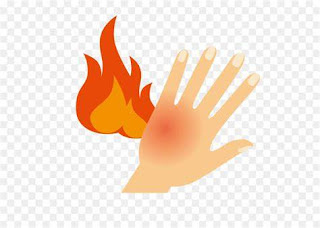Burns are a global public health problem. This is due to the high rate of burn mortality and morbidity, especially in low- and middle-income countries, where more than 95% of the incidence of burns causes death (mortality). However, death is not the only consequence of burns. Many burn patients eventually experience disability (morbidity). This often creates a stigma against community rejection. (Ziaeian, Boback and Gregg C. Fonarow. (2016).)
Burns (combustio) are tissue loss caused by contact with heat sources such as water, fire, chemicals, electricity, and radiation. Burns will cause not only skin damage, but also affect the entire body system (Brunner & Suddarth, 2014)
Burns are a form of tissue damage and or loss caused by contact with sources that have very high temperatures (eg fire, hot water, chemicals, electricity, and radiation) or very low temperatures. Upon contact with a heat source (or other cause). A chemical reaction takes place that drains energy from the tissue so that the cell is reduced and damaged (Moenadjat 2014)
Burns are damage to body tissues, especially the skin as a result of direct or intermediary with chemical, electrical, and radiation heat sources. Burns are wounds caused by heat trauma which give symptoms depending on the area and location of the wound (Brunner & Suddarth, 2014)
Nursing Assessment
Assessment of patients with burns is intended to collect the latest data and information about the patient's status, with the assessment of the Iitegument system as an assessment priority. Systematic assessment of the patient includes a history specifically related to difficulty moving, palpitations. Each symptom should be evaluated for its time and duration as well as its precipitating factors.
1) Client identity. In addition to the client's name, age, gender, religion, occupation and education.
2) Activity/rest. Signs: decreased strength, resistance, limited range of motion in the affected area, impaired muscle mass, changes in tone.
3) Circulation. Signs: hypotension (shock), decreased peripheral pulse distal to the injured extremity, generalized peripheral vasoconstriction with loss of pulse, white and cold skin (electrical shock), tachycardia, dysrhythmias, tissue edema formation.
4) Ego integrity. Symptoms: problems with family, work, finances, disability. Signs: anxiety, crying, dependence, denial, withdrawal, anger.
5) Elimination. Signs: decreased/absent urine output during the emergency phase, color may be reddish black in the presence of myoglobin, indicating deep muscle damage, diuresis (after capillary leakage and mobilization of fluid into the body circulation), decreased bowel sounds are absent.
6) Food or liquid. Signs: generalized tissue oedema, anorexia, nausea/vomiting. Symptoms: decreased appetite, bowel sounds and decreased intestinal peristalsis, changes in bowel habits.
7) Neurosensory. Symptoms: border area, tingling. Signs: changes in orientation, affect, behavior, decreased deep tendon reflexes in extremity injuries, seizure activity, corneal laceration, retinal damage, decreased sharpness vision.
8) Pain/comfort. Symptoms: various pains, e.g., first degree burns are extremely sensitive to touch, pressure, air movement, and temperature changes.
9) Breathing. Symptoms: confined in an enclosed space, prolonged exposure (possible inhalation injury). Signs: shortness of breath, coughing wheezing, carbon particles in sputum, inability to swallow oral secretions and cyanosis, indications of inhalation injury. Thoracic expansion may be limited to the presence of burns to the chest circumference, airway or stridor/wheezing (obstruction related to laryngospasm, laryngeal edema), breath sounds: deep airway secretions (rhonchi).
10) Security. Signs: generalized skin: deep tissue instruction may not be evident for 3-5 days in connection with the process microvascular thrombus in some wounds.
11) Medical history
- Chief complaint: infection in burns
- History of present illness: Most or most of the causes of burns are due to electric shock, heat, temperature, chemical mediators.
- Past medical history: the client does not have a history of previous illnesses related to burns.
- Family history of disease: no case correlation on family members to the incidence of burn infection. (Price, A. Sylvia 2014)
